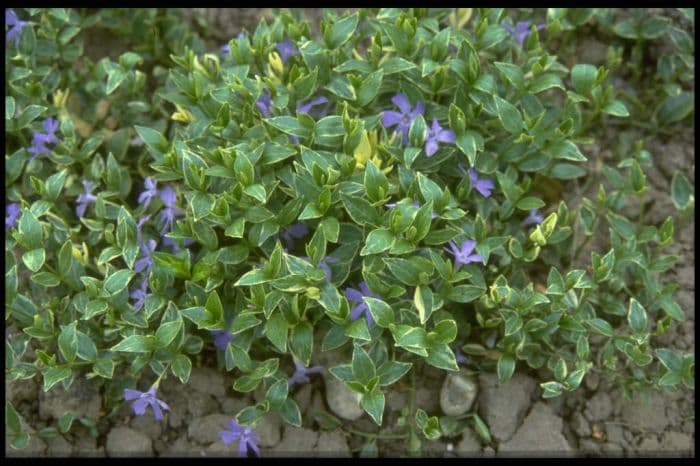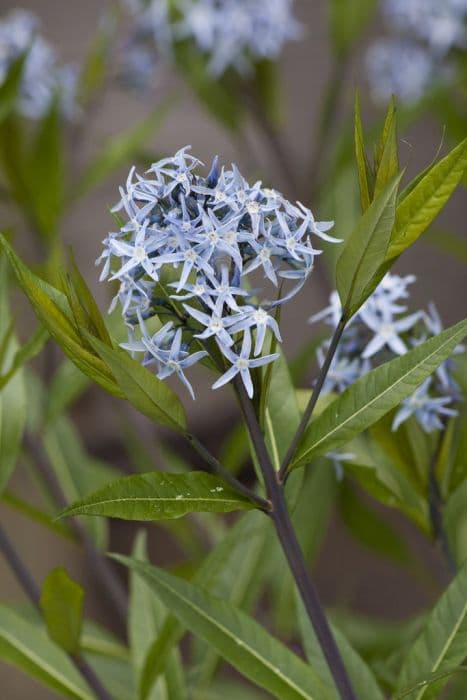Variegated Periwinkle Vinca minor 'Argenteovariegata' (v)

ABOUT
Vinca minor 'Argenteovariegata', commonly known as variegated lesser periwinkle, is a decorative ground cover plant characterized by its striking foliage and dainty flowers. This plant displays beautiful variegated leaves that are oval to lance-shaped, featuring a mix of green and creamy white edges. The contrast of colors on the leaves adds a distinct visual interest throughout the growing season. The flowers of the variegated lesser periwinkle are quite charming. They typically appear in the spring and intermittently throughout the summer. These blooms are small, with a radial shape, boasting a delicate blue-violet hue that stands out against the variegated leaves. The overall appearance of the plant is a dense, mat-forming spread that elegantly covers the ground, creating a lush and vibrant undergrowth. In addition to the variegated foliage and blue-violet flowers, the plant has slender stems that weave and interlock, providing a stable and attractive base for the leaves and blooms. The leaves may also display a glossy sheen, catching the light and further enhancing the visual allure of this ground-hugging plant. While the variegated lesser periwinkle is primarily grown for its ornamental value in gardens and landscapes, its appearance is not only appealing but also useful for adding color and contrast in shade gardens or under trees where other plants might struggle to thrive. The combination of variegated leaves and periwinkle flowers makes it a top choice for gardeners looking to enhance the aesthetic of their outdoor spaces.
About this plant
 Names
NamesFamily
Apocynaceae.
Synonyms
Variegated Periwinkle, Myrtle, Dwarf Periwinkle.
Common names
Vinca minor 'Argenteovariegata'
 Toxicity
ToxicityTo humans
Periwinkle is considered toxic if ingested by humans. It contains alkaloids, including vincamine, which can cause adverse health effects. Symptoms of periwinkle poisoning may include nausea, vomiting, diarrhea, abdominal pain, hypotension (low blood pressure), depression of the central nervous system, and seizures. In severe cases, ingestion of periwinkle can potentially lead to coma or death.
To pets
Periwinkle is toxic to pets such as dogs and cats. It contains alkaloids such as vincamine, which can cause similar symptoms in pets as it does in humans if ingested. Symptoms of periwinkle poisoning in pets might include vomiting, diarrhea, low blood pressure, depression, incoordination, and seizures. In severe cases, ingesting periwinkle can be life-threatening for pets.
 Characteristics
CharacteristicsLife cycle
Perennials
Foliage type
Evergreen
Color of leaves
Variegated
Flower color
Blue
Height
4-6 inches (10-15 cm)
Spread
1-2 feet (30-60 cm)
Plant type
Groundcover
Hardiness zones
4-9
Native area
Europe
Benefits
 General Benefits
General Benefits- Ground cover: Vinca minor 'Argenteovariegata' spreads effectively to cover bare spots in the garden, creating a lush carpet of greenery.
- Low maintenance: This variety of periwinkle requires minimal care once established, making it an excellent choice for gardeners of all skill levels.
- Drought tolerance: It can withstand periods of dry weather, reducing the need for frequent watering.
- Shade tolerance: The plant thrives in shaded areas where other plants might struggle, making it ideal for underplanting beneath trees and shrubs.
- Erosion control: Its mat-forming habit helps prevent soil erosion on slopes and banks.
- Ornamental leaves: The variegated foliage adds visual interest to the landscape throughout the growing season.
- Deer resistance: Periwinkle is generally resistant to deer, which can be beneficial in areas where deer browsing is a problem.
- Pest resistance: It has few serious pest problems, contributing to its ease of care.
 Medical Properties
Medical PropertiesThis plant is not used for medical purposes.
 Air-purifying Qualities
Air-purifying QualitiesThis plant is not specifically known for air purifying qualities.
 Other Uses
Other Uses- Vinca minor 'Argenteovariegata', commonly known as variegated periwinkle, can be used in crafting for its decorative leaves, which add a touch of variegation to flower arrangements and wreaths.
- The plant's trailing habit makes it useful in creating living curtains or green walls when grown vertically on suitable supports or trellises.
- It can serve as a natural dye source, as the leaves of variegated periwinkle can be used to produce a range of green hues in textile dyeing.
- The plant is sometimes used in educational settings to teach concepts of variegation and plant propagation to students.
- Variegated periwinkle is employed in landscape design not just for ground cover, but also to outline or highlight pathways and borders with its contrasting foliage.
- In aquariums that accommodate semi-aquatic plants, variegated periwinkle can be grown emersed to add diversity to the setup.
- The resilient nature of the plant allows it to be used in areas experiencing soil erosion, where its roots help bind the soil.
- During festive seasons, its leaves and stems can be incorporated into natural gift wrapping options for an eco-friendly touch.
- In outdoor settings such as patios or balconies, potted variegated periwinkle can be used to provide a low-maintenance pop of foliage color with its white and green leaves.
- For photographers and artists, the plant provides a variegated pattern and texture backdrop for close-up photography and botanical illustrations.
Interesting Facts
 Feng Shui
Feng ShuiThe plant Vinca is not used in Feng Shui practice.
 Zodiac Sign Compitability
Zodiac Sign CompitabilityThe plant Vinca is not used in astrology practice.
 Plant Symbolism
Plant Symbolism- Perseverance: Commonly known as lesser periwinkle, Vinca minor 'Argenteovariegata' symbolizes perseverance due to its ability to survive in challenging conditions and its evergreen nature.
- Eternal Love: The lesser periwinkle has been used in the past to represent everlasting love, stemming from its use in wreaths and its year-round presence.
- Memories: The round shape of lesser periwinkle flowers is sometimes associated with the circle of life and thus can symbolize memories or immortality.
- Friendship: Its hardy and enduring nature allows the lesser periwinkle to also symbolize strong and lasting friendships.
 Water
WaterVariegated periwinkle should be watered regularly but with moderation, aiming to keep the soil consistently moist but not waterlogged. During the growing season in spring and summer, watering once a week, with approximately 1 gallon per square yard, should be sufficient. Reduce watering frequency in fall and decrease to only when necessary in winter, especially for outdoor plantings. If grown in containers, check the top inch of soil and water when it feels dry to the touch. Overwatering can lead to root rot, so it's important to ensure good drainage.
 Light
LightVariegated periwinkle thrives best in partial shade to full shade conditions. The plant can tolerate some morning sun, but it should be protected from harsh afternoon sunlight to prevent leaf burn. An ideal spot would be under the dappled shade of trees or on the north side of a building where it can receive bright but indirect light throughout the day.
 Temperature
TemperatureVariegated periwinkle is a hardy plant that can survive in a wide range of temperatures. It can withstand winter lows down to about 0°F and is tolerant of summer heat as long as the roots are kept cool with mulch or shade. The ideal temperature range for optimal growth is between 60°F and 80°F, avoiding extremes on both ends of the spectrum to maintain plant health.
 Pruning
PruningVariegated periwinkle should be pruned to control its spread, encourage bushier growth, and remove any dead or yellowing leaves. Pruning is best done in early spring or after flowering to shape the plant and maintain the desired size. It's a vigorous grower, so occasional pruning throughout the growing season may be necessary to keep it tidy. During these pruning sessions, simply trim back the plant to prevent it from overpowering neighboring plants.
 Cleaning
CleaningAs needed
 Soil
SoilThe best soil mix for Vinca minor, commonly known as variegated periwinkle, should be well-draining and rich in organic matter. A mixture of loamy garden soil, peat moss, and perlite or sand is suitable. The ideal pH range for variegated periwinkle is slightly acidic to neutral, around 6.0 to 7.0.
 Repotting
RepottingVariegated periwinkle typically doesn't require frequent repotting because it's a ground cover plant that spreads horizontally. Repotting can be done every 2-3 years or when the plant overgrows its container or the soil appears exhausted.
 Humidity & Misting
Humidity & MistingVariegated periwinkle thrives under average to high humidity levels but is quite adaptable and can tolerate lower humidity as well. No specific humidity level is essential for the variegated periwinkle.
 Suitable locations
Suitable locationsIndoor
Place in indirect light, water when soil feels dry.
Outdoor
Partial shade, moist well-drained soil, shelter from hot sun.
Hardiness zone
4-9 USDA
 Life cycle
Life cycleVinca minor 'Argenteovariegata', commonly known as variegated lesser periwinkle, starts its life as a seed, which upon finding adequate conditions for moisture and temperature, germinates and sprouts into a seedling. The seedling stage involves the development of the first true leaves, after which the plant enters the vegetative growth stage where it produces stems and leaves, spreading out horizontally to form mats. A mature variegated lesser periwinkle then enters the flowering stage, which typically occurs in the spring, producing attractive lavender-blue flowers that are often used in ornamental displays. After pollination, the flowers develop into fruit, which are dry capsules that split open to release the seeds for the next generation. The plant may also reproduce vegetatively through its root system, as the stems can root at the nodes when they come in contact with the soil. Variegated lesser periwinkle is a perennial, meaning it will go through these growth and reproductive cycles year after year.
 Propogation
PropogationPropogation time
Spring-Early Summer
Propogation: Common periwinkle 'Argenteovariegata' is typically propagated through stem cuttings. The best time to take cuttings for propagation is in late spring or early summer when the plant's growth is most vigorous. To propagate, a gardener should select a healthy, non-flowering stem and cut a 4 to 6-inch (approximately 10 to 15 centimeters) length, making sure that each cutting has at least three sets of leaves. The bottom set of leaves is removed, and the cut end of the stem is dipped in rooting hormone powder. This prepared cutting is then placed in a well-draining potting mix, ensuring that the leaf nodes, where the leaves were removed, are buried in the soil. The soil should be kept moist but not waterlogged, and the pot is ideally placed in a warm, shaded area until roots develop and new growth becomes evident, signalling successful propagation.








